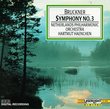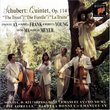| All Artists: Chopin, Moravec Title: Ivan Moravec Plays Chopin, Vol.2 (The Four Ballades, Five Mazurkas) Members Wishing: 2 Total Copies: 0 Label: Video Artists Int'l Release Date: 12/27/1994 Genre: Classical Styles: Chamber Music, Forms & Genres, Ballads, Historical Periods, Classical (c.1770-1830) Number of Discs: 1 SwapaCD Credits: 1 UPC: 089948109228 |
Search - Chopin, Moravec :: Ivan Moravec Plays Chopin, Vol.2 (The Four Ballades, Five Mazurkas)
 | Chopin, Moravec Ivan Moravec Plays Chopin, Vol.2 (The Four Ballades, Five Mazurkas) Genre: Classical
Ivan Moravec's Chopin is always compelling. He makes each one of the Ballades into a compelling story, reinforcing his imaginative approach to the music with superb tonal and dynamic resources. Each of the Mazurkas also be... more » |
Larger Image |
CD DetailsSynopsis
Amazon.com Ivan Moravec's Chopin is always compelling. He makes each one of the Ballades into a compelling story, reinforcing his imaginative approach to the music with superb tonal and dynamic resources. Each of the Mazurkas also becomes an individual experience, with rhythmic shadings as effective as the tonal shadings. Since there is only one other recording of a single Ballade by Moravec, and the five Mazurkas he recorded for Vox are all different from the ones here, the disc becomes a compelling item for Moravec fans and pianophiles in general, even though it contains only 54:39 of music. The late sixties recordings still sound wonderful. --Leslie Gerber Similar CDs
Similarly Requested CDs |
CD ReviewsChopin painted with a delicate brush and with many hues John Grabowski | USA | 08/29/2005 (5 out of 5 stars) "Where to begin with this remarkable and special recording? ...Well, for starters, no matter how many other recordings you have of these warhorses, no matter how satisfied you are with the ones you have, you need to hear this. Put this disc on, listen closely, listen again, listen again, then go back and listen to whatever your previous yardstick had been, and I doubt you'll be as satisfied. You'll be surprised how limited the palettes of so many other pianists sound.
Occasionally a disc will not be just enjoyable. It will teach me as well. This disc taught me to hear really closely, paying attention to how even repeated figurations can be oh so subtly altered from phrase to phrase. Morevec has a seemingly bottomless range of expressive resources. A lesser pianist will dip into the same "bag of techniques" when the score demands it (see my review of Zimerman in the Ballades), but someone like Moravec has a seemingly limitless supply of techniques, one for each occasion, never recycled. His imagination is just tremendous. Just listen to the first ballade. The phrasing in the second phrase is so carefully shaded and nuanced. Not even considering any musical qualities, Moravec's sheer muscular control must be incredible. Then listen to the first two phrases of the first theme proper. Pay attention to the left hand in the bass notes--they're shaded subtly--oh so subtly--different. Again, Moravec's touch is just astonishing--extremely varied but very natural and never fussy. As the great critic Henry Fogel put it, "very subtly and sensitively colored and phrased." Yet it's never fussy self-indulgence; rather, it feels as though he's making up these works at the keyboard, and that you are hearing them for the first time. And that sums up all these works. Moravec, one of the most underrated pianists out there today (he's still alive and performing; one of the last greats from the bygone years), is, like Horowitz, a colorist. But whereas Horowitz boldly slashes at the canvas with bold primary colors, Moravec sketches with soft pastels. In certain works, though, it's just the right approach. Just as I wouldn't want to see the Sistine Chapel in watercolor, I wouldn't want to hear Moravec do the Hammerklavier. But in the right works, his accounts can be breath-taking. Yes, sometimes I wish there was more spine in these readings. Sometimes things meander a bit, especially in Ballade No. 3, and some climaxes may not be forceful enough. No matter to me; there are plenty of other, forceful versions, but only one Moravec. While this should not be your only set of ballades, it should be near the top of your list. In a world of piano clones, Moravec is special and unique. So is this CD. And while you're at it, check out his Chopin nocturnes, too. And his Beethoven Op. 90. You'll find yourself asking, "Is Perahia really necessary?"" |

 Track Listings (9) - Disc #1
Track Listings (9) - Disc #1










